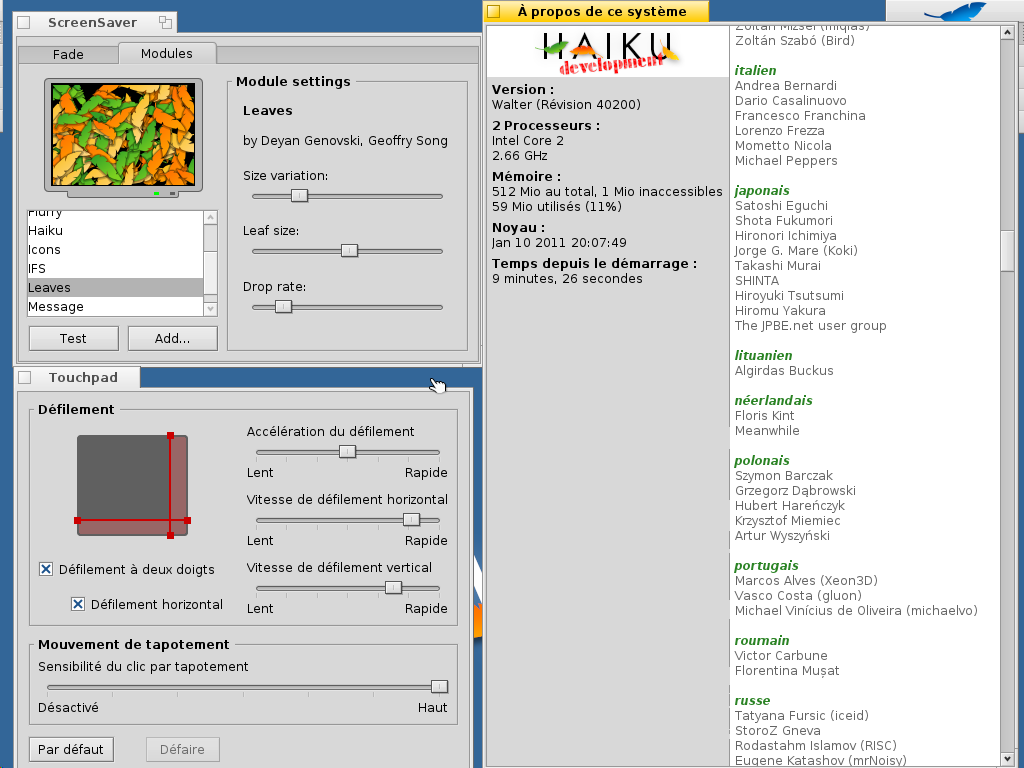The Google Code In is now over. I’d like to thank all of the students, and the Haiku mentors, 30 in all, for all their hard work. I’d also like to thank Google, the Melange team and Carol Smith for running GCI. Haiku had over 150 tasks completed by students!
Many of the tasks completed for Haiku were for translations. In all, there were about 65 translation tasks completed, nearly completing 12 different languages, and partial coverage on 7 more. One student, when we couldn’t find a mentor to cover the Romanian translations, went out and found a mentor, and then she proceeded to translate all of the apps and preflets that are in HTA, all while she was also doing tasks for several other orgs. In case anyone is interested in working on the translations there is still a lot of work left to do on some of the less common languages. If you are interested in helping out, join the Haiku-i18n mailing list. To work on the localization of the system, go to HTA, register and get started. To start a new translation team for the user guide, read Starting a new translation.

Haiku get's a couple of new screensavers, several new translators for many languages, and some more i18n'd applications and preferences thanks to GCI students.
Most people think of fonts as merely a means to an end, but in this lesson we will take a crash course in typography and the very basics of displaying text in Haiku. Also included is a review of the second unit, lessons 6 through 15.
Programming With Haiku , Unit 2 Review Programming With Haiku, Lesson 16
The following is a first draft of how package management on Haiku could look like. I’m more than sure that there are aspects missing here, but we need to start the discussion somewhere …
Several people have already added their ideas on package management to the wiki article. Additionally, many opinions have been stated in comments to my first blog entry.
I have tried to incorporate most ideas mentioned into this draft, but due to the sheer amount of contradicting views, some sacrifices have to be made.
“Make everything as simple as possible, but not simpler."
Starting my month of paid Haiku-work today, I was quite astonished to see the many emotional comments that have been added to the announcement. Clearly, the topic seems to be one of heavy likes and dislikes …
Having read all those comments and most of the discussions we had earlier (on the wiki and on the mailing lists), I felt the need to start my blog with the quote given above - as, for me, that pretty much summarizes what there is to say about package management …
We got a question today on the #haiku channel if there is interest in setting up a Haiku buildbot for Gnash. If anyone is interested join #gnash on irc.freenode.net
http://wiki.gnashdev.org/BuildBot
As you might have noticed, the WiFi encryption bounty ends tomorrow. Obviously, this is a good time to give an overview over what I did in the past weeks. Unfortunately, and hopefully before I got you excited, the most interesting thing of the bounty, the wpa_supplicant, does not work yet. I've ported it to Haiku, but so far it has resisted my attempts to find out where the problem is located -- well, in the hours I put into debugging I've found a couple of potential causes, but there is at least one more to be found, and fixed.
Depending on what kind of projects you write, you may have to create a new file type from time to time, such as a document type for the next Word-killing word processor. While not difficult, making one needs a bit of knowledge from different places in the OS and the API. In our final lesson which focuses on the Storage Kit, we will learn about MIME types, how to show the OS how to automatically identify files of your new type, and more.
A holiday treat! In this lesson we continue to work our way through the Storage Kit, learning about one of the lesser-known features of the Haiku API: node monitoring. For those new to Haiku, it notifies programs of changes to the filesystem, such as changes in a name, etc. If you’re looking to turn a good Haiku app into a fine one, this is one way to do it.
Programming with Haiku, Lesson 14
I’m not talking about databases, either. In this lesson, we examine one of the most distinctive features Haiku has: the query. We get a good, long look into the murky depths that are the query’s official syntax, Reverse Polish Notation, and a few other weird and wonderful tricks. Enjoy!
Programming with Haiku, Lesson 13





